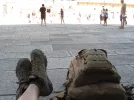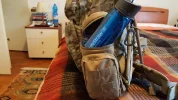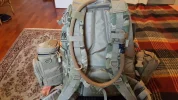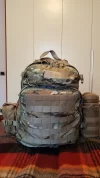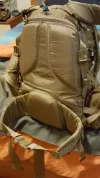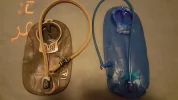==========
This is why I did state that, in the end, the choice of rucksack was one of the most important and personal choices you make wen gearing up for a Camino.
Similarly, the choice of a water-toting system is as personal and indivudal to suit your needs. I do not HAVE to use 4-external half-liter bottles. I CHOOSE to use them, as it suits MY needs. Here is why...
My personal health issues compel me to ingest a flavored, protein powder / water solution every four hours. I have one for "breakfast" before I start my day's walking. But, that still leaves one pre-mix that hangs on the rucksack front harness for later consumption, after 3-4 hours.
Then, after a couple hours walking, I perspire enough even on a rainy and raw day to need an electrolyte replacement after a couple of hours. Plain water is not enough for my personal situation. So, a pre-mix and flavored electrolyte solution hangs in a second half-liter bottle on my front harness.
Finally, I start-off in the morning carrying two half-liter bottles of plain water, for drinking as I feel the need, and for emergency use to rinse a wound (mine or another pilgrim's). All of these four bottles are readily accessible while I am walking. I do not need to stop to remove water from a side rucksack pocket. I did on my first Camino, and it was a genuine pain.
As these bottles become empty, I rinse and refill them with known potable water from safe sources. However, I only refill the empties according to the remaining time and distance I have to cover that day.
All this said, IF I were younger, did not have the health issues I just happen to have, and could drink water from the many fuentes that do have potable water, I might use a different water carry method. I envy folks who can drink puddle water and not get the "trots." But, I have a sensitive gut...
If I did not have he dietary and health issues that I happen to have, I would likely reduce to only two, half-liter bottles. But I still prefer this method to a bladder.
On my first Camino, I did have a 2-liter water bladder in my Osprey Kestrel pack. It lasted four days, until Pamplona, where I mailed it down the road to Ivar at Santiago.
For me, it was inconvenient, because:
- First, it weighed more on my back than hung on my front harness. Even empty, the bladder system weighed 11 ounces (@ 312 grams).
- Second, keeping it clean daily was problematic, and I am a fussy about hygiene of all types, but especially drinking water. After death, IMHO, perhaps the absolute WORST thing that can occur while on Camino is any kind of gastrointestinal illness. 'Nuff said on that point...
- Third, it did not find my "medical-need profile" for mixing protein or electrolyte solutions with water. Sure, I could have added the powders to the bladder, but then would have a sole-purpose solution in the bladder. Then we are back to the maintenance and cleaning issue...
So, in the end, my solution works for me. It may, or may not work for you. But, regardless of the solution you ultimately choose, just be comfortable with it. That is all that matters.
I hope this helps.







